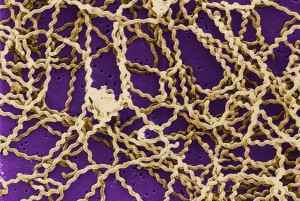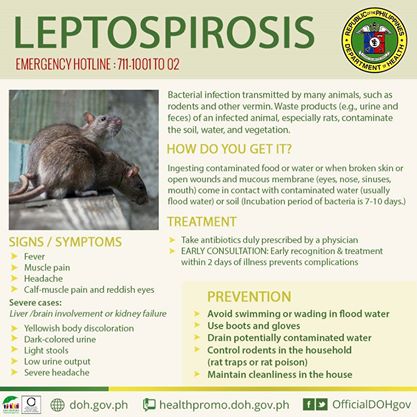The Department of Health (DOH) reported a total of 316 leptospirosis cases nationwide from January 1 to July 5, which is 56.71 percent lower compared to the 730 recorded in the same period last year, according to the Philippines News Agency.

In the DOH latest surveillance on leptospirosis, it reported that most of the cases came from Region VI with 78 cases (24.68 percent), followed by Region II with 49 cases or (15.51 percent), Region X with 28 cases (8.86 percent); Region III, 26 (8.23 percent); and CARAGA, 25 (7.91 percent). There were 19 deaths reported.
Also leptospirosis cases has shown a reduction at the National Capital Region with 22 reported in the first half of the year compared to the 90 cases in the same period last year. This is 75.56 lower compared to the same period last year.
Leptospirosis is a bacterial zoonotic disease caused by the corkscrew shaped organism, Leptospira. It goes by several other names depending on the locale; mud fever, swamp fever, sugar cane and Fort Bragg fever, among others. It is a disease of both humans and animals.
The rat is the main host to Leptospira. However, other animals such as cattle, pigs, horses, dogs, rodents, and wild animals can carry the bacterium.
People become infected by direct or indirect contact with the urine of these animals. Contact with urine-contaminated water is extremely important. Contaminated food and soil containing animal urine are other potential sources of infection.
The bacterium enters through contact with skin. Especially through cuts or breaks in the skin and through mucous membranes like the eyes.
Found worldwide, it was long considered an occupational disease (miners, farming, vets, and sugarcaneharvesting and sewer workers), it is increasingly associated with recreational water sports and camping.
Symptoms of leptospirosis, if present, appear in up to 4 weeks after exposure. Sometimes the person will show no symptoms or mild flu-like symptoms.
According to the CDC, Leptospirosis may occur in two phases; after the first phase, with fever, chills, headache, muscle aches, vomiting, or diarrhea, the patient may recover for a time but become ill again. If a second phase occurs, it is more severe; the person may have kidney or liver failure (jaundice) or meningitis. This phase is also called Weil’s disease.
Leptospirosis is confirmed by laboratory testing of a blood or urine sample.
The infection can be treated with antibiotics (penicillin and doxycycline), especially if started early in the disease. For very ill patients, intensive care support and IV antibiotic may be necessary.
For more infectious disease news and information, visit and “like” the Infectious Disease News Facebook page


